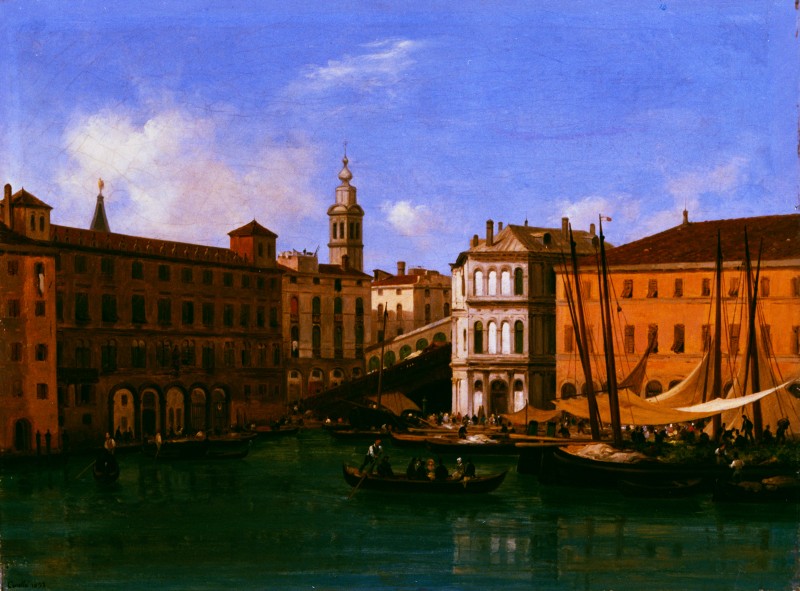Artgate_Fondazione_Cariplo_-_Canella_Giuseppe,_Barconi_a_Rialto.jpg (800 × 591 pixels, file size: 116 KB, MIME type: image/jpeg)
| This is a file from the Wikimedia Commons. Information from its description page there is shown below. Commons is a freely licensed media file repository. You can help. |
Summary
| Giuseppe Canella: Barges at the Rialto
( |
|||||||||||||||||||||||||||
|---|---|---|---|---|---|---|---|---|---|---|---|---|---|---|---|---|---|---|---|---|---|---|---|---|---|---|---|
| Artist |
artist QS:P170,Q956210 |
||||||||||||||||||||||||||
| Title |
Barges at the Rialto label QS:Len,"Barges at the Rialto"
label QS:Lit,"Barconi a Rialto" |
||||||||||||||||||||||||||
| Object type |
painting object_type QS:P31,Q3305213 |
||||||||||||||||||||||||||
| Description |
The work was painted in 1833 and shows the Rialto bridge on the Grand Canal with the Palazzo dei Camerlenghi and the Fabbriche Vecchie on the right and the Fondaco Fondaco dei Tedeschi on the left. It does not appear to have been one of the Venetian views presented the following year at the Esposizione di Belle Arti di Brera, where the numerous canvases shown included Riva degli Schiavoni and The Mouth of the Rio di Castello in Venice. Canella’s presence in Venice is securely documented in 1815 and again in 1837 on the occasion of his long East European journey through the cities of Vienna, Berlin, Dresden, Pest and Prague. The date of the work does not rule out the possibility of the view having been studied during the artist’s first stay in Venice, as he built up his figurative repertoire by filling his sketchbooks with as many subjects as possible, drawn from life with great fluency during his travels for later use, sometimes after an interval of many years. This working method is documented, for example, by Seascape on the Coast of Barcelona (1833) [1] and Travellers at Rest in Spain (1839, Brescia, Civici Musei) [2], both based on a trip to Spain made in the period 1820–22. The same view of the Rialto was depicted by Antonio Canal, known as Canaletto, in a celebrated painting formerly in the collection of Joseph Smith, the British consul in Venice (Royal Collection at Winsor Castle [3]), which Canella may have known through the engraving by Antonio Visentini, in circulation as from 1735. While Canaletto’s work focuses on the precise depiction of the monumental buildings, painted from different angles and suitably rearranged within a panoramic view, Canella’s sticks very close to reality and was unquestionably painted on the spot from a slightly low and off-centre viewpoint in such a way as to highlight the mercantile activities at the expense both of the buildings, where lively figures are shown hanging out the washing on the terraces, and of the bridge itself, which is half-hidden in the distance. For this painting too, Canella drew contrasting reactions from critics on the occasion of the exhibitions in Milan by adopting a bright, enamel-like kind of light borrowed from the northern landscape painting that the artist had the opportunity to study during his repeated travels in the Netherlands. Through his realistic approach and handling of light and atmosphere, the artist championed a radical renewal in perspective view painting with respect both to the romantic and to the Venetian models that were very popular at the time in Milan, where they had been widely circulated as from the mid-1810s through precise small-sized copies of works by Giovanni Migliara (including the View of the Doges’ Palace in Venice, Cariplo Collection) and by the Venetian painter Bernardino Bison as from 1831. Evidence of the commercial success of this Venetian subject in particular with a cultured international clientele is also provided by the (now lost) canvas painted by Giuseppe Canella around 1838 for Count Kolowrat, the Austrian minister of state and a great collector of Italian art, which may have been a replica of the work in the Cariplo Collection. |
||||||||||||||||||||||||||
| Date |
1833 date QS:P571,+1833-00-00T00:00:00Z/9 |
||||||||||||||||||||||||||
| Medium |
oil on canvas medium QS:P186,Q296955;P186,Q12321255,P518,Q861259 |
||||||||||||||||||||||||||
| Dimensions |
height: 36.2 cm (14.2 in); width: 48.8 cm (19.2 in) dimensions QS:P2048,36.2U174728 dimensions QS:P2049,48.8U174728 |
||||||||||||||||||||||||||
| Collection |
institution QS:P195,Q2054135 |
||||||||||||||||||||||||||
| Current location |
Italiano: Sezione VI |
||||||||||||||||||||||||||
| Accession number |
AH01521AFC |
||||||||||||||||||||||||||
| Inscriptions |
Signature bottom left: Canella 1833
|
||||||||||||||||||||||||||
| Notes | Elena Lissoni, Artgate Fondazione Cariplo | ||||||||||||||||||||||||||
| References |
|
||||||||||||||||||||||||||
| Source/Photographer | Artgate Fondazione Cariplo | ||||||||||||||||||||||||||
| Permission (Reusing this file) |
This file is licensed under the Creative Commons Attribution-Share Alike 3.0 Unported license. Attribution: Fondazione Cariplo
|
||||||||||||||||||||||||||
Licensing
- You are free:
- to share – to copy, distribute and transmit the work
- to remix – to adapt the work
- Under the following conditions:
- attribution – You must give appropriate credit, provide a link to the license, and indicate if changes were made. You may do so in any reasonable manner, but not in any way that suggests the licensor endorses you or your use.
- share alike – If you remix, transform, or build upon the material, you must distribute your contributions under the same or compatible license as the original.
Captions
Items portrayed in this file
depicts
image/jpeg
585a82ecf7c44ae6f5f7820917bd25f526d6d891
119,104 byte
591 pixel
800 pixel
File history
Click on a date/time to view the file as it appeared at that time.
| Date/Time | Thumbnail | Dimensions | User | Comment | |
|---|---|---|---|---|---|
| current | 09:17, 11 September 2011 |  | 800 × 591 (116 KB) | M.casanova |
File usage
The following page uses this file:
Global file usage
The following other wikis use this file:
- Usage on ar.wikipedia.org
- Usage on it.wikipedia.org
- Usage on it.wikibooks.org
- Usage on pl.wikipedia.org


